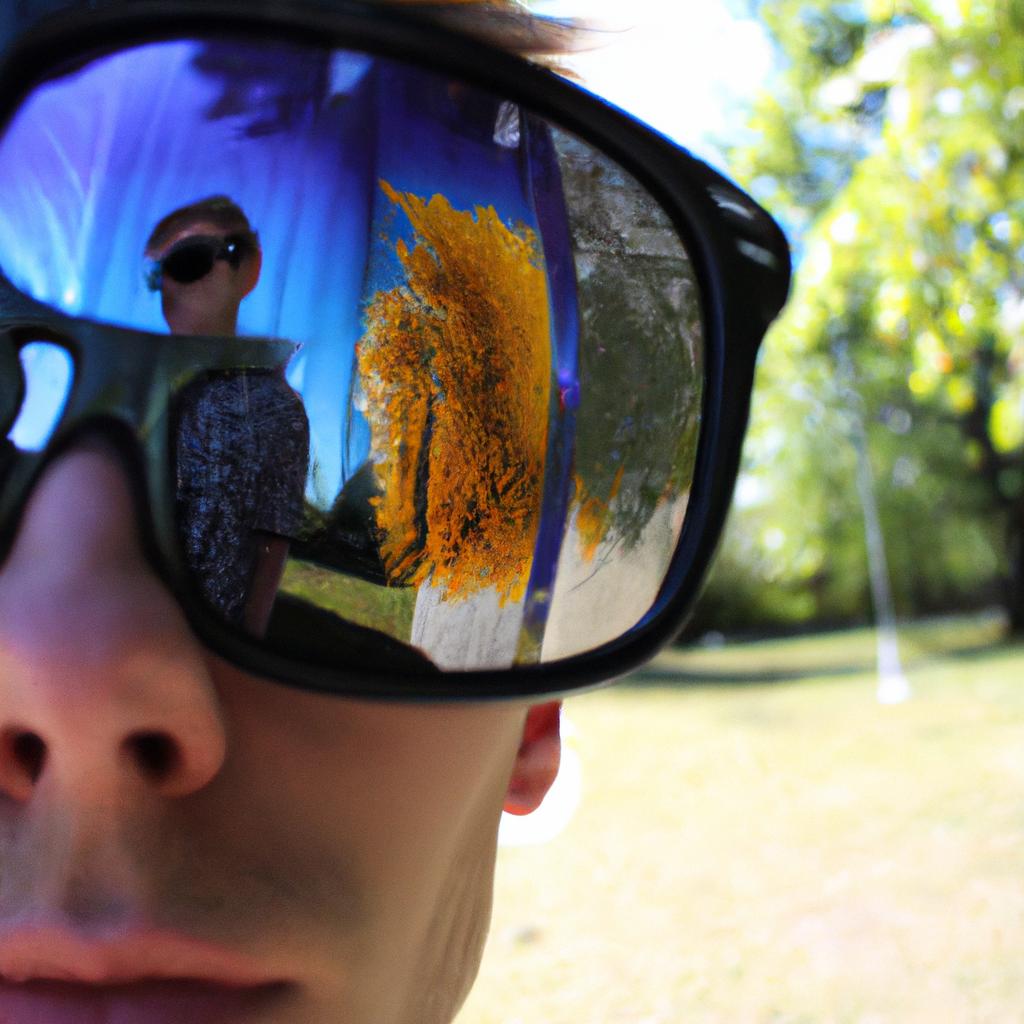UV Protection in Sunglasses: Everything You Need to Know

Sunglasses have long been regarded as a fashionable accessory, but their true significance lies in the protection they provide against harmful ultraviolet (UV) rays. It is crucial for individuals to be aware of the potential dangers associated with prolonged exposure to UV radiation and to understand how sunglasses can effectively mitigate these risks. This article aims to delve into the topic of UV protection in sunglasses, providing readers with an in-depth understanding of the various aspects involved.
Consider this hypothetical scenario: Lisa, a young woman living in a coastal city, spends her summer days basking on the beach without wearing any form of eye protection. Unbeknownst to her, the intense sunlight she soaks up exposes her eyes to high levels of UV radiation. As time goes by, Lisa begins experiencing discomfort such as redness, itchiness, and sensitivity when exposed to bright light. After seeking medical advice, she discovers that she has developed photokeratitis – a condition caused by excessive UV exposure. Such incidents highlight the importance of understanding and utilizing proper UV protection measures like sunglasses.
This article will explore the different types of UV radiation, discuss their effects on human health, analyze the mechanisms through which sunglasses offer UV Protection, and evaluate factors to consider when purchasing sunglasses for optimal sun safety.
The Importance of Mirrored Coatings
Imagine yourself on a sunny day, enjoying a leisurely walk along the beach. As you stroll, you notice a person wearing sunglasses with mirrored lenses. Their eyes are shielded from the intense glare and harmful UV rays, allowing them to comfortably enjoy their surroundings. This is just one example of how mirrored coatings on sunglasses play an essential role in protecting our eyes.
Mirrored coatings offer several advantages that go beyond mere aesthetics. Firstly, they reduce the amount of light entering our eyes by reflecting it away. By doing so, these coatings effectively minimize glare caused by sunlight bouncing off surfaces such as water or snow. The reduction in glare enhances visual clarity and prevents eye strain, enabling us to see more clearly even in bright environments.
In addition to reducing glare, mirrored coatings provide significant protection against harmful ultraviolet (UV) radiation emitted by the sun. Exposure to UV rays can lead to various eye conditions like cataracts, macular degeneration, and pterygium. By incorporating specialized materials into the coating process, manufacturers ensure that these sunglasses block out most UV radiation. It is important to note that not all mirrored lenses offer equal levels of UV protection; therefore, when selecting sunglasses for optimal safety, it is crucial to choose ones with a high level of UV filtering capability.
- Reduced risk of developing eye conditions caused by excessive exposure to UV radiation
- Enhanced visual comfort and reduced eyestrain due to minimized glare
- Improved visibility in bright outdoor environments
- Increased durability of sunglass lenses through scratch resistance properties
Moreover, we can also emphasize these benefits using a table format:
| Benefit | Description |
|---|---|
| Reduced risk of eye conditions | Protects against cataracts, macular degeneration, and pterygium |
| Enhanced visual comfort | Minimizes glare and prevents eye strain |
| Improved visibility in bright environments | Allows for better vision when exposed to intense sunlight or reflective surfaces |
| Increased lens durability | Provides scratch resistance, prolonging the lifespan of sunglass lenses |
In conclusion, mirrored coatings on sunglasses offer more than just a stylish appearance. These coatings reduce glare, enhance visual clarity, and provide crucial protection against harmful UV radiation. By investing in sunglasses with high-quality mirrored coatings, we can safeguard our eyes from potential damage while enjoying outdoor activities. With this understanding of the importance of mirrored coatings established, let us now explore another aspect of eye safety: enhancing it further with wraparound frames.
Enhancing Eye Safety with Wraparound Frames
Transitioning from the importance of mirrored coatings, another crucial aspect to consider when choosing sunglasses is the frame design. The right frame can significantly enhance eye safety by providing additional protection against harmful UV rays and external elements. Let’s explore how wraparound frames offer superior eye safety compared to traditional sunglass designs.
Imagine a scenario where two individuals are exposed to intense sunlight for an extended period. One person wears regular sunglasses with standard frames, while the other opts for wraparound frames specifically designed to provide maximum coverage. After several hours, both individuals take off their sunglasses and analyze their experience.
The individual wearing regular sunglasses notices some discomfort around their eyes due to exposure to peripheral sunlight. In contrast, the person wearing wraparound frames experienced minimal discomfort as the design effectively shielded their eyes from direct and indirect sun rays. This example highlights one advantage of using wraparound frames: enhanced eye safety through extensive coverage.
Consider these key points regarding wraparound frames:
- Increased Protection: Wraparound frames extend further around the face, providing added protection against harmful UV radiation from various angles.
- Minimized Peripheral Light: By minimizing peripheral light entering from the sides, top, or bottom of the glasses, wraparound frames reduce glare and potential damage caused by excessive brightness.
- Improved Wind Resistance: The snug fit offered by wraparound frames helps prevent wind and dust particles from reaching your eyes during outdoor activities such as cycling or running.
- Stylish Options: Modern eyewear brands now offer a wide range of stylish wraparound frame designs that prioritize both fashion and function.
To illustrate this further, let’s examine a comparison between traditional sunglass designs and wraparound frames in terms of features:
| Features | Traditional Sunglasses | Wraparound Frames |
|---|---|---|
| Coverage Area | Limited | Extensive |
| Glare Reduction | Moderate | Effective |
| Wind/Dust Proof | Less Resistant | High Resistance |
| Fashion Options | Varied | Wide Range Available |
As seen in the table above, wraparound frames outperform traditional sunglasses in terms of coverage area and resistance to wind and dust. The comparative analysis emphasizes the benefits of investing in sunglasses with wraparound frames for enhanced eye safety.
Transitioning into our next section, let’s explore another important aspect of sunglasses: gradient tint. By understanding how this feature works, we can better appreciate its advantages when it comes to optimizing visual clarity and comfort.
Understanding the Benefits of Gradient Tint
Transitioning from the previous section on enhancing eye safety with wraparound frames, let us now delve into another aspect of sunglasses – understanding the benefits of gradient tint. To illustrate its significance, consider a hypothetical scenario where an individual is wearing sunglasses while driving towards the setting sun. As they approach a bend in the road, their vision becomes obstructed by blinding glare. In this situation, gradient tint lenses could prove invaluable in providing clear visibility and preventing accidents.
Gradient tint lenses are characterized by a gradual transition in lens color density, typically darker at the top and lighter at the bottom. This design allows for optimal protection against bright sunlight overhead while still allowing sufficient light transmission through the lower portion of the lens for clearer vision. There are several key benefits to using sunglasses with gradient tint:
- Visual Comfort: The gradual change in lens darkness helps reduce discomfort caused by sudden shifts between bright and dark areas. It provides a more natural visual experience when transitioning from shaded to well-lit environments.
- Enhanced Contrast: Gradient tints improve contrast perception by selectively reducing excessive brightness without compromising clarity or distorting colors. This can be particularly advantageous during activities such as driving or participating in outdoor sports.
- Fashionable Aesthetic: Beyond their functional advantages, gradient-tinted sunglasses offer a stylish touch that appeals to many individuals seeking both eye protection and fashionable accessories.
- Gradient tint lenses provide:
- Improved visual comfort
- Enhanced contrast perception
- Protection against excessive brightness
- A fashionable aesthetic
Additionally, we can present some relevant information in a table format:
| Benefits of Gradient Tint Lenses |
|---|
| Improved visual comfort |
In summary, gradient tint lenses offer various advantages when it comes to protecting your eyes and improving visual experiences under different lighting conditions. By reducing glare from overhead sunlight and maintaining clarity in the lower portion of the lens, these sunglasses ensure both comfort and safety for a wide range of activities. Now, let’s explore another feature that can enhance your visual experience: reducing glare with anti-reflective coatings.
Reducing Glare with Anti-Reflective Coatings
Imagine yourself sitting on a beach, overlooking the sparkling ocean. As you reach for your sunglasses to shield your eyes from the bright sunlight, you notice something fascinating – the lenses have a gradient tint. This type of sunglass lens has gained popularity due to its unique design and numerous benefits.
One example that showcases the advantages of gradient tint is when driving during sunset. The top portion of the lens, which is darker, helps reduce glare from overhead sources such as streetlights or signs. At the same time, the bottom part with a lighter shade allows for better visibility of the dashboard and surrounding objects. This seamless transition in shading ensures optimal eye comfort while ensuring clarity in different lighting conditions.
To further understand why gradient tints are highly sought after, consider these key points:
- Enhanced style: Gradient tints add an element of sophistication and fashion-forwardness to any pair of sunglasses.
- Versatility: Whether you’re engaging in outdoor activities or attending a social event, gradient-tinted lenses offer versatility by adapting to various lighting environments.
- Subtle protection: While primarily known for their aesthetic appeal, gradient tints still provide some level of UV protection throughout the entire lens area.
- Eye relaxation: By reducing harsh light at the top and allowing more natural light through at the bottom, gradient tints minimize eye strain and fatigue.
Table – Comparing Different Tint Types:
| Solid Tint | Mirror Coating | Gradient Tint | |
|---|---|---|---|
| Aesthetic | Bold | Reflective | Subtle |
| Light | Uniform | Reflected | Graduated |
| Visibility | Consistent | Diminished | Adaptability |
In conclusion, understanding the benefits of gradient tint in sunglasses reveals how it can enhance both style and visual comfort. With its ability to reduce glare effectively while maintaining clarity, gradient tints offer versatility in various lighting conditions. Moreover, they provide a subtle level of UV protection to safeguard your eyes from harmful rays. Now let’s explore another essential feature: reducing glare with anti-reflective coatings.
Transition sentence into the subsequent section about “Choosing Sunglasses with Advanced Coating Technologies”: Keeping these considerations in mind, it is important to also explore sunglasses that incorporate advanced coating technologies for optimal eye protection and enhanced vision.
Choosing Sunglasses with Advanced Coating Technologies
Imagine this scenario: you’re driving on a bright sunny day, and the glare from the road is making it difficult to see clearly. You put on your sunglasses, expecting relief from the blinding sunlight. However, you notice that even with your shades on, there’s still some residual glare affecting your vision. This is where anti-reflective coatings come into play.
Anti-reflective coatings are thin layers applied to sunglass lenses that reduce reflections and increase clarity by eliminating unwanted light interference. These coatings work by minimizing both internal and external reflections, allowing more light to pass through the lens without bouncing back or scattering. By doing so, they enhance visual acuity and provide a clearer view of objects in high-glare environments.
To further understand how anti-reflective coatings improve sunglass performance, let’s explore their benefits:
-
Enhanced Vision: By reducing reflections, these coatings help eliminate unnecessary distractions caused by glares and halos around bright lights. Whether you’re driving at night or spending time outdoors during the day, an enhanced visual experience can significantly improve safety and overall comfort.
-
Increased Comfort: Glare not only affects visibility but also causes eye fatigue and discomfort over prolonged periods. With anti-reflective coatings, you can minimize eyestrain and enjoy extended periods of comfortable wear without squinting or straining your eyes.
-
Improved Aesthetics: In addition to practical benefits, these coatings also enhance the appearance of sunglasses by reducing distracting reflections on the lens surface. The absence of visible reflections allows others to see your eyes clearly while maintaining a sleeker look for your eyewear.
-
Better Eye Contact: When engaging in face-to-face conversations while wearing sunglasses with anti-reflective coatings, people can make direct eye contact with you as these coatings minimize reflective barriers between the wearer’s eyes and those of others.
| Benefit | |
|---|---|
| 1. | Enhanced Vision |
| 2. | Increased Comfort |
| 3. | Improved Aesthetics |
| 4. | Better Eye Contact |
Incorporating anti-reflective coatings in your sunglasses can significantly enhance your visual experience, increase comfort, and improve overall aesthetics. Now, let’s delve into the world of advanced coating technologies and explore how mirrored coatings further enhance UV ray blockage.
How Mirrored Coatings Enhance UV Ray Blockage
UV Protection in Sunglasses: Everything You Need to Know
Choosing Sunglasses with Advanced Coating Technologies has become increasingly important for individuals looking to protect their eyes from harmful UV rays. However, another factor that can enhance the blockage of these rays is the use of Mirrored Coatings on sunglasses lenses. By reflecting light and reducing glare, mirrored coatings offer an additional layer of protection against UV radiation.
To understand how mirrored coatings work, let’s consider a hypothetical case study involving two pairs of sunglasses: one with a traditional lens and another with a mirrored coating. In this scenario, both sunglasses have identical specifications in terms of lens material and UV protection level. The only difference lies in the presence or absence of a mirrored coating on the second pair.
When exposed to bright sunlight, the wearer of the first pair experiences some discomfort due to excessive glare and reflections bouncing off surfaces such as water, snow, or shiny objects. On the other hand, the individual wearing the second pair with a mirrored coating notices reduced glare and enhanced clarity. This improvement is possible because the mirror-like finish reflects much of the incoming light away from the eyes, allowing for better visual acuity even in high-glare conditions.
Mirrored coatings are particularly beneficial in various outdoor activities where intense sunlight and strong reflections are common occurrences. Whether engaging in water sports like surfing or skiing down snowy slopes, having sunglasses with mirrored coatings offers several advantages:
- Improved visibility by reducing glare
- Enhanced eye comfort under bright conditions
- Better contrast perception for improved depth perception
- Added style and aesthetic appeal
The benefits provided by Mirrored Coatings make them an attractive option for those seeking optimal UV protection while enjoying outdoor activities. As we explore further into our discussion about shielding UV rays, it becomes evident that not only do advanced coating technologies play a vital role but also factors such as frame design come into play.
The Role of Wraparound Frames in Shielding UV Rays
Building upon the discussion of mirrored coatings and their role in enhancing UV ray blockage, we now turn our attention to another critical factor in sunglasses’ ability to shield against harmful UV rays – the design of wraparound frames. By understanding how these frames contribute to UV protection, we can make informed decisions when selecting sunglasses that best safeguard our eyes.
Wraparound frames are specifically designed with a curvature that extends beyond the temples, offering greater coverage and protection from all angles. This unique construction plays a pivotal role in minimizing exposure to UV radiation. To illustrate this point, let us consider an example: imagine two individuals spending equal time outdoors on a sunny day – one wearing traditional flat-fronted sunglasses and the other sporting wraparound frames. Despite both pairs having identical lens materials and coatings, the individual wearing wraparound frames would experience significantly reduced UV exposure due to the frame’s extended coverage area.
To better understand how wraparound frames provide enhanced UV protection, it is essential to consider the following aspects:
- Increased Peripheral Coverage: The curved design of wraparound frames ensures that they snugly fit around the face, extending further towards the temples than conventional sunglass styles. This wider coverage limits peripheral light entering through gaps at the sides and top of regular eyewear.
- Reduced Reflections: Wraparound frames minimize reflections by wrapping closer to the face. As a result, less ambient light bounces off surrounding surfaces (e.g., water or snow) into the eyes from oblique angles.
- Enhanced Comfort and Stability: Due to their close-fitting nature, wraparound frames offer improved comfort during physical activities such as sports or outdoor adventures. These sunglasses stay securely on your face even during vigorous movements, ensuring consistent eye protection throughout various motions.
- Fashionable Options Available: Manufacturers have recognized the importance of style alongside functionality. Today, there are numerous fashionable options available for those seeking trendy sunglasses with excellent wraparound designs.
| Aspect | Benefits |
|---|---|
| Increased Peripheral | Minimizes UV exposure from side and top angles |
| Coverage | |
| Reduced Reflections | Limits reflections for enhanced visual clarity |
| Enhanced Comfort and | Ensures a secure fit during physical activities |
| Stability | such as sports or outdoor adventures |
| Fashionable Options | Provides style options without compromising |
| Available | functionality |
In conclusion, the design of wraparound frames significantly contributes to the effectiveness of sunglasses in shielding against harmful UV rays. Their extended coverage area, reduced reflections, improved comfort and stability, along with fashionable options available make them an excellent choice for individuals prioritizing both eye protection and style.
Now that we have explored the role of wraparound frames in UV ray shielding, let us delve into another crucial aspect – the impact of gradient tint on UV protection.
The Impact of Gradient Tint on UV Protection
Building on the importance of wraparound frames in shielding UV rays, understanding the Impact of Gradient Tint on UV protection is crucial. Let’s explore how this feature contributes to effective sun protection.
To illustrate the significance of gradient tint, consider a hypothetical scenario where two individuals are wearing sunglasses while spending time outdoors under direct sunlight. Person A is wearing sunglasses with a uniform tint throughout the lens, while person B has opted for sunglasses with a gradient tint that gradually becomes lighter towards the bottom of the lens. As they both enjoy their outdoor activities, we can observe some key differences:
-
Enhanced Visual Comfort: The gradual transition from darker to lighter tint in gradient lenses allows for more comfortable vision by reducing glare at eye level without compromising clarity. This ensures better visibility and reduces eye strain during prolonged exposure to bright light conditions.
-
Versatile Light Adaptation: With its ability to provide varying levels of darkness within a single lens, gradient tints offer versatility in adapting to different lighting environments seamlessly. By allowing more light transmission at the bottom part of the lens, these sunglasses enable wearers to have clearer vision when looking downwards or engaging in close-up tasks.
-
Fashionable Appeal: Apart from their functional benefits, gradient-tinted sunglasses also add a touch of style and sophistication to any outfit. They effortlessly combine functionality with fashion-forward aesthetics, making them an appealing choice for those seeking both sun protection and trendy eyewear options.
- Gradual transition enhances visual comfort.
- Versatility enables seamless adaptation to various lighting conditions.
- Stylish design adds flair to outfits.
- Provides superior sun protection for your eyes.
| Benefit | Description |
|---|---|
| Enhanced Visual Comfort | Reduces glare and minimizes eye strain through a gradual dark-to-light tint |
| Versatile Light Adaptation | Adapts to different lighting environments by adjusting light transmission |
| Fashionable Appeal | Adds style and sophistication to any outfit |
| Superior Sun Protection | Shields eyes from harmful UV rays with optimal coverage |
In summary, gradient tint in sunglasses offers enhanced visual comfort, versatile light adaptation, fashionable appeal, and superior sun protection. These features make them a valuable choice for outdoor enthusiasts seeking both functionality and style.
As we delve further into the science of protecting our eyes, let’s now explore the role of anti-reflective coatings in blocking UV rays.
The Science Behind Anti-Reflective Coatings and UV Rays
Imagine you’re sitting outside on a sunny day, wearing your favorite sunglasses with gradient tint lenses. As you look around, you notice that the top part of the lens is darker than the bottom. You may wonder how this gradient tint affects the level of UV protection provided by your sunglasses.
Gradient tinted sunglasses are designed to provide varying levels of darkness throughout the lens. The purpose behind this design is twofold: to reduce glare from overhead sunlight and to enhance visibility in lower light conditions. However, it’s important to understand that while gradient tints can be aesthetically pleasing, their impact on UV protection varies depending on factors such as the specific color and density of the tint.
To shed more light on this topic, let’s consider some key points:
-
Varying UV Protection: Gradient tints typically offer less UV protection at the bottom portion of the lens compared to the top. This means that when looking through the lighter area at the bottom, your eyes may receive increased exposure to harmful UV rays. It’s crucial to choose sunglasses that still provide adequate overall UV protection despite any variation in tint density.
-
Lens Color Matters: Different colors absorb different wavelengths of light, including UV radiation. For example, gray or green-tinted lenses tend to have better overall UV-blocking capabilities compared to brown or amber ones. When selecting gradient-tinted sunglasses for optimal UV protection, keep in mind that certain colors might affect how effectively they shield your eyes from harmful rays.
-
Personal Sensitivity: Individuals’ sensitivity to bright light and glare varies greatly. Some people find gradient tints helpful in reducing excessive brightness without compromising clarity of vision, while others may prefer uniform dark lenses for maximum sunblockage. Consider your own visual comfort needs when deciding whether gradient-tinted sunglasses are suitable for you.
Now let’s take a closer look at these concepts in the following table:
| Gradient Tint Color | Top Lens UV Protection | Bottom Lens UV Protection |
|---|---|---|
| Gray or Green | High | Moderate |
| Brown or Amber | Moderate | Low |
This table illustrates how different gradient tint colors can impact the level of UV protection provided by sunglasses. While gray or green tints offer higher overall UV protection, brown or amber tints provide a lower level of shielding from harmful rays.
In summary, when considering gradient-tinted sunglasses for their aesthetic appeal and functionality, it’s essential to understand any potential trade-offs in terms of UV protection. The choice between uniform dark lenses and those with varying levels of darkness throughout ultimately depends on personal preference and visual comfort requirements.
Transitioning into the subsequent section about “Making Informed Decisions for Optimal UV Protection,” it is crucial to carefully evaluate various factors before purchasing sunglasses that prioritize effective sunblockage while still meeting your needs and preferences.
Making Informed Decisions for Optimal UV Protection
In the previous section, we explored the importance of anti-reflective coatings in providing optimal UV protection. Now, let’s delve deeper into the science behind these coatings and their effectiveness against harmful UV rays.
Imagine a scenario where two individuals are exposed to sunlight for an extended period: Person A wearing sunglasses with anti-reflective coating, and Person B without any coating. As they bask in the sun’s warmth, both individuals unknowingly subject their eyes to potentially damaging ultraviolet (UV) radiation.
To understand how anti-reflective coatings work, it is essential to consider how light interacts with different surfaces. When light hits an uncoated lens surface like that of person B’s sunglasses, some of it gets reflected off the lens instead of passing through. This reflection can cause glare and reduce visual clarity, but more importantly, it can also bounce back onto the eyes, increasing exposure to harmful UV rays.
Anti-reflective coatings address this issue by reducing reflections on lenses. They consist of multiple layers that help minimize unwanted reflections while allowing maximum transmission of visible light. By reducing reflections, these coatings not only improve overall vision quality but also limit the amount of UV radiation reaching our eyes.
To emphasize the significance of choosing sunglasses with effective anti-reflective coatings for adequate UV protection:
- Protect your long-term eye health: Prolonged exposure to UV radiation increases the risk of cataracts, macular degeneration, and other eye conditions.
- Preserve visual comfort: Excessive glare from reflecting light can strain your eyes and make tasks such as driving or outdoor activities uncomfortable.
- Enhance color perception: Anti-reflective coatings eliminate distracting reflections, enabling better color perception and enhancing visual acuity.
- Increase durability: These coatings provide an extra layer of protection against scratches and smudges on your sunglass lenses.
To further illustrate the benefits of anti-reflective coatings, consider the following table:
| Without Anti-Reflective Coating | With Anti-Reflective Coating | |
|---|---|---|
| Glare Reduction | Moderate | Significant |
| UV Protection | Limited | Enhanced |
| Visual Clarity | Impaired | Improved |
| Scratch Resistance | Standard | Increased |
As you can see, sunglasses with effective anti-reflective coatings offer considerable advantages over those without. By reducing glare, enhancing visual clarity, and providing enhanced UV protection, these coatings play a crucial role in safeguarding your eyes against potential harm.
In summary, the science behind anti-reflective coatings highlights their ability to minimize reflections on sunglass lenses while allowing maximum transmission of visible light. This not only improves vision quality but also protects our eyes from harmful UV radiation. Choosing sunglasses equipped with effective anti-reflective coatings ensures long-term eye health, visual comfort, color perception enhancement, and increased durability. Make an informed decision when selecting your next pair of sunglasses for optimal UV protection.




